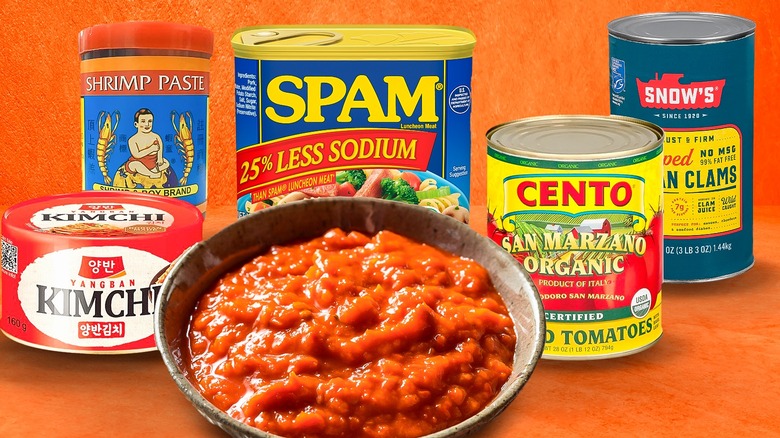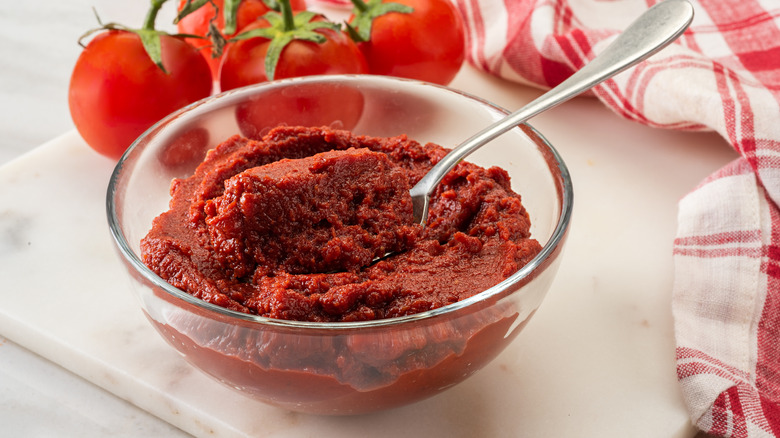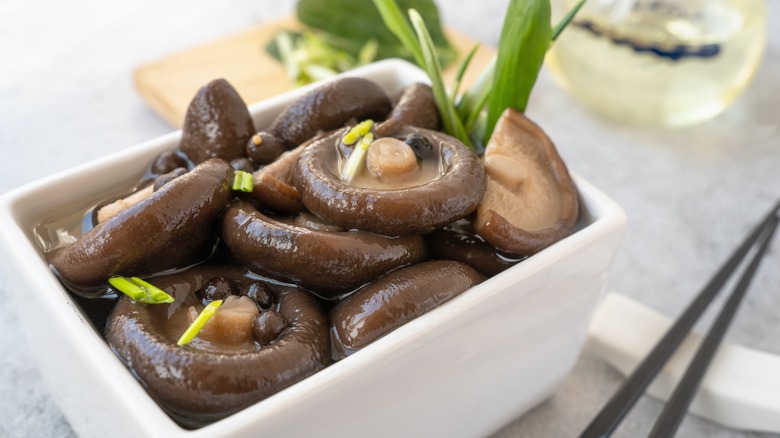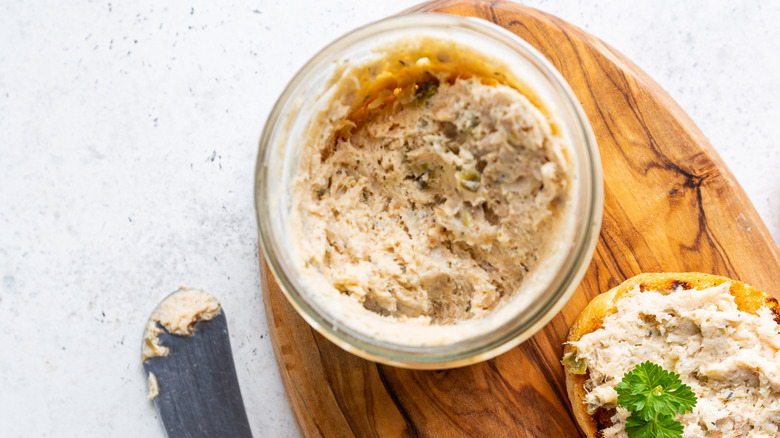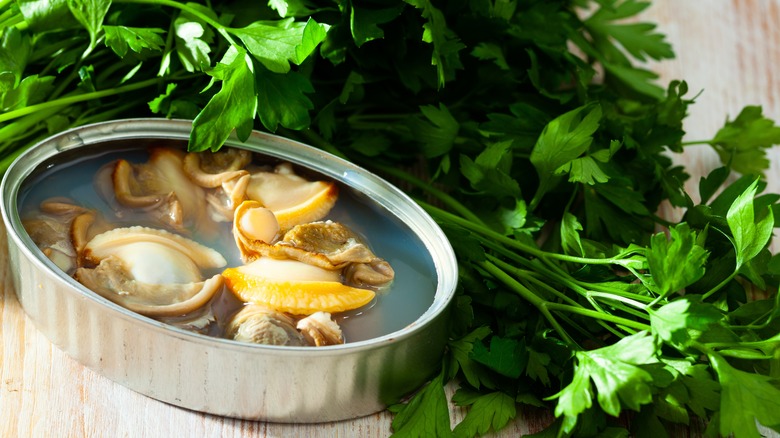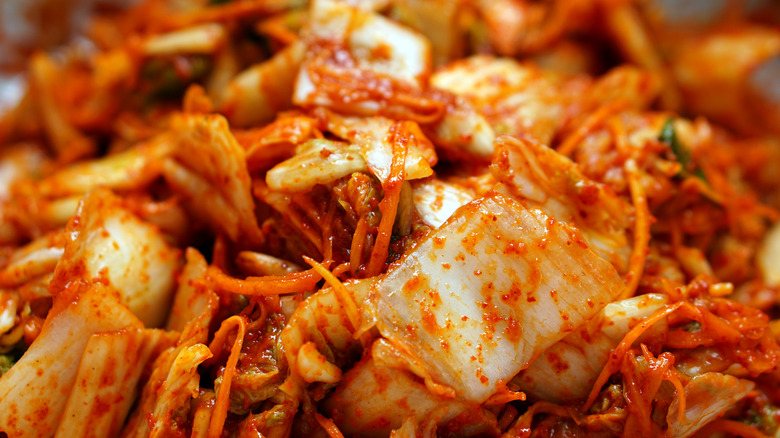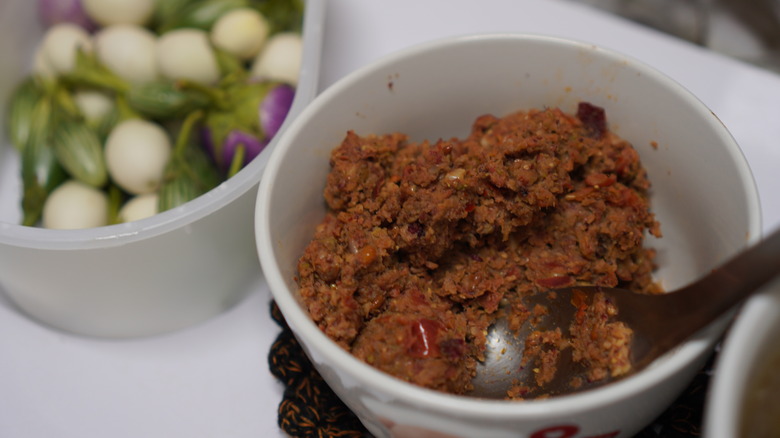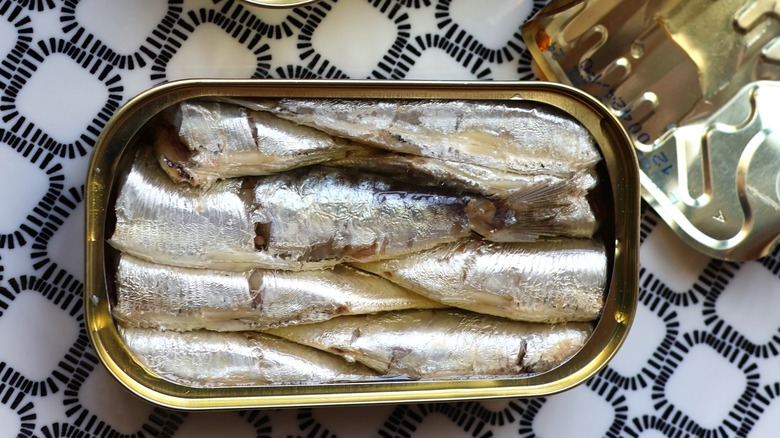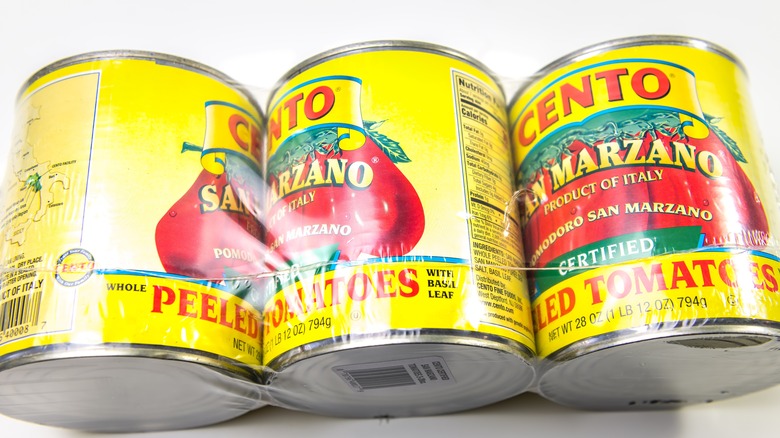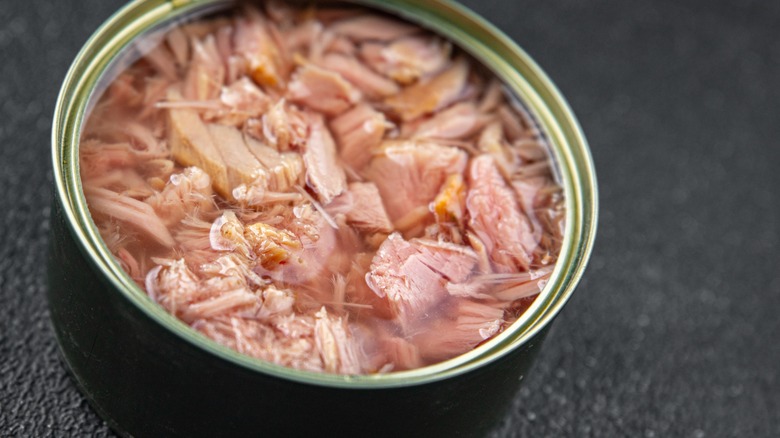12 Canned Ingredients That Add An Umami Punch To Sauces
For anyone ready to reach that next level of the culinary arts, it's time to learn more about the basic elements of food and flavor. Picasso didn't jump into cubism without knowing how to create beautiful realism. The most important thing to know about flavors is that they all fall into one of five categories: Salty, sweet, sour, bitter, and umami. Umami is the lesser-known flavor that was the last to be named.
The term "umami" was only keyed a little over 100 years ago when Professor Dr. Kikunae Ikeda identified glutamate in kombu seaweed as giving it a meaty, savory flavor. Glutamate is what provides any food with its umami flavor. It's best described as deeply savory and can help to add depth to recipes, including sauces. As a chef and recipe designer, I'm always looking for simple ways to include umami in my dishes. When you are desperate for that meaty richness, turn to your pantry for canned ingredients that add an umami punch to sauces.
Now, if you are still having trouble identifying the fifth flavor, think about the depth that dried porcini and shiitake mushrooms have. Think about bouillon cubes, tinned fish, gamey meats, soy sauce, miso, and even peas. Umami is different than just being salty; although the two are often confused, umami is more complex. The job of sauce is to carry the flavor of a dish while complementing whatever it is served with, so it's important that it's layered with flavor. Umami helps, whether you're making pasta sauce, salad dressing, gravy, or stir-fry sauce.
Tomato paste
Perhaps one of the most universally loved umami-rich sauces is marinara. Tomatoes are incredibly meaty and become even more savory when cooked down. They are a high-glutamate food and a top pick for vegetarians interested in adding something substantial to their sauce. This is why tomato paste is one of my favorite canned ingredients to add an umami punch to sauces. It's easy to work with, it helps add a pop of color to your dish and is layered with rich flavors. It's thick and has a sweetness to it, balanced by undertones of acidity. Tomato paste has a rounded mouthfeel and can help to bring life to your sauce.
Tomato paste can be included in almost any kind of savory sauce you can brainstorm. It's incredible in gravy, a sauce that is typically designed to be umami-rich. It can help add brightness and life to your stir-fry sauce, it can help thicken your salad dressing and is an essential ingredient in any barbecue sauce. Don't forget to mix it into your burger and french-fry dipping sauces.
To get the most out of your tomato paste, consider caramelizing it first. It helps to concentrate the sugars creating an incredibly sweet and flavorful paste. It only takes a few minutes and is worth the extra effort. Simply heat a pan over medium heat, add some olive oil, and once it's hot, add your tablespoon or two of tomato paste. Keep it moving so it doesn't burn; when it starts to change color about three to five minutes in, it should be ready to remove from the heat.
Canned shiitake mushrooms
Mushrooms are unique because they are unlike any vegetable or meat, but contain some flavor and textural elements of both. They are often described as meaty, and chewy but are sometimes mistaken for vegetables, although they are fungus. Their savory and rich flavors land them in the umami category, especially when dried or cooked. Shiitake mushrooms in particular have a powerful umami flavor, often described as smokey, nutty, or earthy. Canned shiitake mushrooms are pre-cooked, but it's still a good idea to heat them before adding them to your sauce.
Although canned mushrooms might not sound like the most appealing thing in the world, they are incredibly convenient, and if used properly can help to boost the umami flavors in your sauce. I would recommend draining these mushrooms and sautéing them in a little olive oil or butter to revive them. Then you can mince, grind, or simply add them to your sauce as is. Canned shiitake mushrooms are wonderful in gravy, pasta sauce, and stir-fry sauce. When it comes to pasta sauce, don't limit yourself to marinara. Mushrooms do well in both a cream and broth-based pasta sauce as well.
Fish paste
Now, not all ingredients can sound appealing right off the bat. Fish paste is one of those items you'd never impulse buy, but it's worth keeping a can in your pantry. As a cooking paste, fish paste is fish that is salted, partially dried, and processed into a spreadable texture. Most of the time it's made with white fish like pollock or hake, and has that white fish mild flavor. However, not all fish paste is made equal, so check the label because sometimes anchovy, tuna, or salmon make an appearance.
Some fish pastes, typically Asian brands, are fermented. This gives it an extra umami punch beyond what comes from the fish itself. The glutamic acid is increased during the fermentation process, helping to amplify those umami flavors, and it's one of the best cooking pastes out there. It's much more intense than the unfermented version so you don't need to use quite as much.
Mix just a small amount into your pasta sauce or stir-fry sauce. Make life easy and mix it with a little melted butter to enjoy over freshly cooked pasta. Even adding a little to your cream sauce can make a huge difference. Because it's not overwhelmingly fishy in flavor and scent, and because you're using just a small amount of it, it adds depth without disrupting the dish. Fish paste may be just what your sauce is missing.
Canned clams
As we know, seafood is best when eaten fresh. For those who can't smell the ocean from your front door, it's time to turn to the next best thing: canned seafood. One of the best seafood from a tin is canned clams. They are sweet and salty. According to the USDA, clams have nearly 3½ grams of glutamic acid per every 100 grams, giving them a depth of umami.
Along with imparting that moreish taste, canned clams are much easier to work with than fresh clams which need to be scrubbed, steamed, and removed from the shells. Their texture is delicate yet chewy which can add a sense of meatiness to a sauce.
Another bonus is that canned clams come in a delicious, briny juice that can boost your sauce as well. Just be sure to cook it down after adding the liquid so that your sauce doesn't come out watery. The addition of canned claims to jarred tomato sauce is a surefire way to make it taste homemade without having to let it simmer for hours.
Consider using canned clams in any pasta sauce beyond a tomato base. My top pick is to use them in a white wine and butter sauce, loaded with garlic (of course). Keep those little mollusks intact instead of mincing them up. This will help to create a beautiful texture in the dish, leaving little pockets of savory and chewy mouthfuls layered into the al dente pasta.
Kimchi
For those who enjoy fermented foods, sauerkraut's spicy cousin kimchi is probably already on your radar. For those who don't know much about it, here's a quick guide to kimchi. It's a Korean food that can be used as a side dish, a garnish, a topping, or even an addition to your sauce. Classic kimchi is made with napa cabbage that has been fermented with Korean chili, but there are endless variations using a variety of vegetables and spices. Sometimes carrots, radishes, and even anchovies are added to the process. Fermentation builds glutamate concentrates in certain foods, like in kimchi.
A typical kimchi is spicy, tangy, and sour from the fermentation process, which also makes it rich in umami. It's still a little crunchy even though the fibers of the cabbage have been broken down during the fermentation process. Because of its texture, this may seems like an out-of-left-filed ingredient for sauce, but you can use kimchi in your stir-fry sauce, or even in your salad dressing. For the former, feel free to leave it shredded if that's how it has been canned, but if it has come with large leaves, then cut it into thin strips. Mix it right into a sauce with tamari or soy sauce, a sweetener of choice, garlic, ginger, and sesame oil. This will help to give the sauce a kick, and a little crunch. For your salad dressing simply mince it up or leave it shredded, and mix it with any vinaigrette.
Shrimp paste
Not all foods can be beautiful, and shrimp paste is no exception. It's a dark, reddish-brown, fermented prawn paste and is sometimes referred to as "prawn sauce." It comes canned or jarred and is used most frequently in Asia, especially coastal China and Southeast Asia. It typically only contains two ingredients: shrimp and salt, and much of the flavor comes from the fermentation process.
Shrimp paste can amplify any savory dish, and here's why: Much like miso, it provides a umami punch to anything it comes in contact with. Shrimp paste differs from fish paste in a few ways. The first is that fish paste isn't always fermented, while shrimp paste is, giving it a funkier taste. Shrimp is also not a fish, but a crustacean, so it has a chewier consistency, even when ground up into paste. Shrimp is sweeter than white fish, and shrimp paste is stronger in flavor, although not as seafood foreward as an anchovy paste, for instance. This means you might use less shrimp paste than fish paste in a recipe, and less shrimp paste than anchovy paste.
I would recommend using shrimp paste in pasta sauces, but also consider it for a sauce over fish to amplify those seafood notes. Use it in a beurre blanc, a lemon dill butter sauce, or even in a creamy béarnaise. Its sweetness will ring, while its umami kick will add layers of depth.
Sardines
You love them or you hate them. Sardines are often confused with anchovies and associated with a strong, intense fish flavor and loads of salt. While they are often salty, they are typically mild when it comes to their fishiness, and instead, they tend to have stronger umami notes. They are chewy, meaty, and pungent, and definitely belong in sauce.
The most classic use of canned sardines in sauce is for pasta dishes. Keep things simple by adding to sardines to a Mediterranean lemon caper sauce, which will punch up the umami significantly. Throw some in your marinara, and even try it in your penne alla vodka or pizza sauce. The biggest mistake you could make is to throw away the oil from the can. That sardine oil can be used in salad dressings, stir fry sauce, to make a sauce to go over fish, and even to simply drizzle over a dish for an extra layer of umami. Elevate your canned sardines by dressing them up with fresh herbs in your sauce. There's nothing better than canned sardines paired with a little fresh sage, olive oil, and lemon juice over a fillet of fish, cooked grains, or a roasted vegetable dish.
Beef broth
Umami is often described as "meaty," so what better canned ingredient to add an umami punch to sauces than beef broth? Beef has a deeply umami taste that emerges as the proteins are cooked down into amino acids, thus loading it with the glutamate that creates umami. As the glutamine breaks down, the flavor intensifies, so something that has cooked as long as broth is power-packed with umami. This is why beef broth makes for a great MSG substitute.
Both beef broth and stock are good options to beef up your sauce – no pun intended. Broth is made using meat, vegetables, and spices, while stock is typically made with bones instead of meat. Bone broth, however, is made with bones but is cooked at a lower temperature for an extended period of time to extract all of the collagen and marrow. Any of these options will contain umami, just be sure to do a taste test from the can before adding it to your sauce as all brands tend to taste slightly different. Add it to your gravy, pasta sauce, or stir-fry sauce before it cooks down. Broth is fully liquid, so unless you're trying to thin your sauce it should be cooked until most of the liquid evaporates. This will also help to condense the flavor.
Anchovies
Hello, intensity. Anchovies are known for their powerful flavor which is a combination of salty, fishy, funky, and umami. However, they aren't just reserved for seafood. They make an appearance in everyday ingredients like Worcestershire sauce and Caesar dressing. This is because they are deeply savory. These little oily fish can be eaten plain, layered onto a sandwich, mixed into pasta, enjoyed over salad ... and can really add umami to any savory sauce. If you are feeling uneasy about adding chunks of fish to your sauce, consider using the oil instead.
Anchovy oil has a milder flavor than the fish itself and is deeply buttery and rich. It still contains all of that umami goodness without those large chewy chunks. There are endless creative uses for anchovy oil, but one of my absolute favorites is to add it to a dipping oil. That means next time you bake up a fresh baguette, scrap the butter and make your own dipping sauce. Use olive oil, parmesan cheese (which is also layered with umami), minced fresh herbs, salt, pepper, red pepper flakes, and of course anchovy oil.
San Marzano tomatoes
When selecting fresh tomatoes, always consider what kind you need for a recipe. Beefsteak? Cherry? Plum? Cherokee purple? When you are choosing canned tomatoes, you should also give the variety more than a second passing thought. One ingredient that adds an umami punch to sauce is canned San Marzano tomatoes. Only real San Marzano tomatoes come from the region of San Marzano in Italy, where they are grown in a volcanic soil that imparts significant mineral flavor to the tomatoes. Look for the D.O.P. label to ensure you're getting the real product, as this implies a designated protected origin.
These tomatoes are special because they are rich in flavor with a dense, meaty taste that's dripping with umami. Plus, they lack the watery aspect that many tomatoes have, given that the flesh is thicker. San Marzanos are a variety of plum tomatoes that have an oblong shape, and often canned as whole tomatoes that are peeled. Their distinct sweetness sticks out as another distinct quality. For these reasons, San Marzano tomatoes make the absolute best for any tomato-based sauce, especially marinara. They can thicken your sauce while providing robust complexity.
Tuna
Although we are used to seeing canned tuna in a mayo-loaded capacity, it has the potential for much more. Tuna is perhaps one of the most common canned fish, but it's been boxed into the sandwich world when it actually can make an amazing sauce, and can even be transformed into a gourmet meal. As one of the meatier fish in the sea, it lacks that strong fishy flavor that drives some people away from seafood. It's tender yet chewy and is buttery and salty, and of course, contains umami. The fifth flavor is often associated with glutamate, but a compound known as inosinate also contributes and imparts food with umami. Tuna is rich in both glutamate and inosinate, making it a great umami ingredient for sauce.
For an easy umami-packed sauce, mix canned tuna with olive oil. Use a high-quality oil, and use this sauce over endless cuisine. Either whisk the two ingredients together with a fork, or use a blender to make it nice and smooth. Of course, it's wonderful over pasta, but try it over avocado toast, a Mediterranean grain bowl, roasted vegetables, or even other seafood.
Spam
No, Spam doesn't stand for Sliced Processed Alien Meat, although it might look a bit out of this world. It actually stands for Specially Processed American Meat, and even if may not have tried it before, it's wildly popular in certain areas of the country, notably Hawaii. Spam is made from pork and tastes similar to ham with a bologna-like texture. It's best served, in my opinion, diced or sliced and pan-fried in fat. To incorporate Spam into your sauce, finely dice or mince it and pan-fry it before mixing it into your pasta sauce.
Pan-fried Spam can be used in any pasta sauce from a meaty tomato base to a creamy alfredo to give it an extra kick of umami. This is why it's a canned meat that you should keep stocked in your pantry at all times. Wait to add salt to your sauce until after you've included the Spam, as it's quite salty itself.
